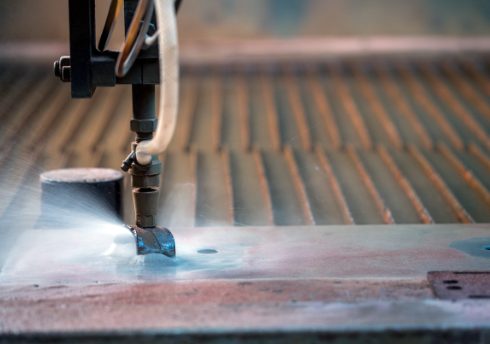Waterjet cutting employs the force of high-pressure water to slice or shape steel, particularly effective for fragile materials. Its methodical sawing action results in clean, accurate cuts. Notably versatile, it can effectively cut through a wide range of materials.
CG Steel offers tailored waterjet cutting solutions tailored to individual client specifications.

Insights into Waterjet Cutting and Its Advantages:
- Precision Cutting: Waterjet cutting provides precise cuts tailored to individual needs and specifications, ensuring high-tolerance parts due to its narrow kerf width.
- Moderate Speed: While not the fastest method in metal fabrication, waterjet cutting offers reliable precision.
- Cost Consideration: Waterjet cutting, especially when combined with plasma, tends to be one of the more expensive techniques in the market.
- Advanced CNC Integration: With CNC technology, programming, layout, and CAD integration are streamlined for efficient operation.
- Cold Cutting: Waterjet cutting is a cold process, avoiding heat-induced transformations in materials.
- Environmental Benefits: Waterjet cutting produces no pollution, harmful air emissions, or dust.
- Versatility: It's the go-to method for cutting compound materials.
- Smooth Edges: Achieves smooth edges, eliminating the need for secondary cutting.
- Single Process: Waterjet cutting combines perforation, cutting, and profiling in one go.
- Cost Efficiency: Offers lower cutting costs compared to alternative methods.
- Automated Control: Highly automated, with precise control over cutting parameters.
- Continuous Operation: Capable of working continuously for 24 hours.
- Cutting Efficiency: No need to change cutting torches, reducing downtime.
- Minimal Blurring: Produces cleaner cuts with minimal blurring.
- Directional Flexibility: Able to cut in various profiles and angles without directional limitations.
Two methods of waterjet cutting are generally employed: pure water cutting and abrasive waterjet cutting.
- Pure water cutting is suited for softer materials like food, rubber, textiles, and leather. In this process, water is pressurized to high levels and then ejected through a small sapphire or ruby nozzle, creating a concentrated cutting stream. This stream moves at approximately 2.5 times the speed of sound, enabling rapid and precise cutting.
- Abrasive waterjet cutting, on the other hand, is designed for harder materials that pure water cutting cannot penetrate. In this method, an abrasive cutting head replaces the water nozzle. The water stream creates a vacuum, drawing abrasive particles into a chamber where they mix with the water, forming a powerful abrasive jet stream.
This abrasive waterjet cutting technique is commonly used for cutting materials such as steel, glass, sheet metal, and aluminum, among others.
How does the waterjet cut intensifier pump works?
The operation of a waterjet cut intensifier pump revolves around generating and maintaining ultra-high pressure, essential for cutting through various materials. At the heart of this process lies the intensifier pump, a component equipped with a robust motor boasting significant horsepower.
Primarily, the pump harnesses hydraulic pressure to achieve its objective. This hydraulic pressure, crucial for powering the piston within a cylinder, is generated through a series of mechanisms. Among these mechanisms are components like a low-pressure water inlet, a water off valve, a boost pump, an accumulator, inlet check valves, and a water filler.
The intensifier pump further integrates an abrasive metering system along with a cutting head to enhance its cutting efficiency. Together, these components ensure the seamless generation and delivery of ultra-high pressure, facilitating precise and effective material cutting in waterjet processes.
In waterjet cutting systems, the primary focus lies in the integration of the clean water system with the low-pressure inlet. Initially, water enters the system and passes through inlet check valves, eventually reaching the hydraulic pump. At this juncture, water undergoes pressurization, exerting pressure on the hydraulic fluid within the pump. This pressurized water is then propelled out of the intensifier and directed into the accumulator. Subsequently, it flows through high-pressure tubing towards the cutting head, where its flow is regulated by an off valve. This valve facilitates the attainment of desired cuts during the waterjet cutting process. Additionally, abrasive material is introduced into the mix within the mixing chamber, further enhancing the cutting capability under high water pressure.
How does the intensifier function in waterjet cutting services?
Many inquire about the mechanism behind the intensifier's ability to generate ultra-high water pressure. Essentially, a larger hydraulic cylinder propels a small piston within a water-filled cylinder, thereby creating the ultra-high water pressure crucial for enhancing the cutting process.
How does the waterjet cutting head operate?
Let's delve into the workings of the waterjet cutting head. High-pressure water is directed into the cutting head via either a hose or high-pressure tubing. Upon reaching the cutting head, the water encounters an orifice, typically composed of durable materials like sapphire or diamond, to withstand the abrasive force of high-pressure water. The orifice's role is to generate the water stream essential for cutting. However, not all materials can be cut solely by water; in such cases, an abrasive, often crushed garnet, is introduced into the water stream. This abrasive material is responsible for the actual cutting process. Additionally, for specialized applications, alternative materials may be utilized. Ultimately, waterjet cutting machines can be tailored to meet the specific requirements of individual users.
Waterjet cutting services are versatile and can be utilized for a variety of materials, including metals like carbon steel, alloy steel, aluminum, and stainless steel, as well as non-metal materials like carbon fiber, plastics, and glass.
At CG Steel, we specialize in providing waterjet cutting services specifically for steel materials, offering precision cuts for the following steel grades:
- Mild/Carbon Steels: ASTM A36, ASTM A516, ASTM A572, ASTM A573. We can accommodate thicknesses of up to 40 mm for carbon steel.
- Stainless Steels: SS304L, SS316L, SS310, and Duplex Stainless Steel.
- Aluminium and Alloy Steels: Including grades like 1050A, 1200, 5083, 5251, 6061, and 6082.
Our waterjet cutting processes maintain tight tolerances, typically within +/- 0.25mm, especially for steel thicknesses under 30 mm.
For customized waterjet cutting solutions tailored to your specific requirements, feel free to reach out to us. We're here to assist you with your cutting needs.








